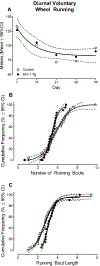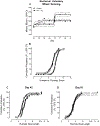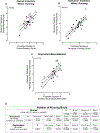Synaptic dysfunction is associated with alterations in the initiation of goal-directed behaviors: Implications for HIV-1-associated apathy
- PMID: 35863502
- PMCID: PMC9990912
- DOI: 10.1016/j.expneurol.2022.114174
Synaptic dysfunction is associated with alterations in the initiation of goal-directed behaviors: Implications for HIV-1-associated apathy
Abstract
Individuals living with human immunodeficiency virus type 1 (HIV-1) exhibit an increased prevalence of neuropsychiatric comorbities (e.g., apathy) relative to their seronegative counterparts. Given the profound functional consequences associated with apathy, characterizing the multidimensional neuropsychiatric syndrome, and associated neural mechanisms, following chronic HIV-1 viral protein exposure remains a critical need. HIV-1-associated apathy was examined by quantifying goal-directed behaviors, indexed using voluntary wheel running, during the diurnal and nocturnal cycle. Apathetic behaviors in the HIV-1 transgenic (Tg) rat were characterized by a profound decrease in the number of running bouts during both the diurnal and nocturnal cycle, supporting a prominent deficit in the self-initiation of spontaneous behaviors. Additionally, HIV-1 Tg animals exhibited a decreased reinforcing efficacy of voluntary wheel running during the nocturnal cycle. Following the completion of voluntary wheel running, synaptic dysfunction in medium spiny neurons (MSNs) of the nucleus accumbens core (NAcc) was examined as a potential neural mechanism underlying HIV-1-associated apathy. HIV-1 Tg animals displayed prominent synaptic dysfunction in MSNs of the NAcc, characterized by enhanced dendritic branching complexity and a population shift towards an immature dendritic spine phenotype relative to control animals. Synaptic dysfunction, which accounted for 42.0% to 68.5% of the variance in the number of running bouts, was strongly associated with the self-initiation of spontaneous behaviors. Establishment of the relationship between synaptic dysfunction and apathy affords a key target for the development of novel therapeutics and cure strategies for affective alterations associated with HIV-1.
Keywords: Apathy; Dendritic spines; Goal-directed behaviors; Human immunodeficiency virus type 1; Nucleus Accumbens; Voluntary wheel running.
Copyright © 2022 Elsevier Inc. All rights reserved.
Conflict of interest statement
Declaration of Competing Interest The authors have no competing interests to declare.
Figures






Similar articles
-
Synaptic Connectivity in Medium Spiny Neurons of the Nucleus Accumbens: A Sex-Dependent Mechanism Underlying Apathy in the HIV-1 Transgenic Rat.Front Behav Neurosci. 2018 Nov 22;12:285. doi: 10.3389/fnbeh.2018.00285. eCollection 2018. Front Behav Neurosci. 2018. PMID: 30524255 Free PMC article.
-
HIV-1 transgenic female rat: synaptodendritic alterations of medium spiny neurons in the nucleus accumbens.J Neuroimmune Pharmacol. 2014 Dec;9(5):642-53. doi: 10.1007/s11481-014-9555-z. Epub 2014 Jul 19. J Neuroimmune Pharmacol. 2014. PMID: 25037595 Free PMC article.
-
Loss of Cdk5 function in the nucleus accumbens decreases wheel running and may mediate age-related declines in voluntary physical activity.J Physiol. 2017 Jan 1;595(1):363-384. doi: 10.1113/JP272489. Epub 2016 Sep 15. J Physiol. 2017. PMID: 27461471 Free PMC article.
-
HIV-Associated Apathy/Depression and Neurocognitive Impairments Reflect Persistent Dopamine Deficits.Cells. 2021 Aug 21;10(8):2158. doi: 10.3390/cells10082158. Cells. 2021. PMID: 34440928 Free PMC article. Review.
-
Neuropathological sequelae of Human Immunodeficiency Virus and apathy: A review of neuropsychological and neuroimaging studies.Neurosci Biobehav Rev. 2015 Aug;55:147-64. doi: 10.1016/j.neubiorev.2015.04.008. Epub 2015 May 2. Neurosci Biobehav Rev. 2015. PMID: 25944459 Review.
Cited by
-
Therapeutically targeting the consequences of HIV-1-associated gastrointestinal dysbiosis: Implications for neurocognitive and affective alterations.Pharmacol Biochem Behav. 2023 Aug;229:173592. doi: 10.1016/j.pbb.2023.173592. Epub 2023 Jun 29. Pharmacol Biochem Behav. 2023. PMID: 37390973 Free PMC article.
References
Publication types
MeSH terms
Grants and funding
LinkOut - more resources
Full Text Sources
Miscellaneous

